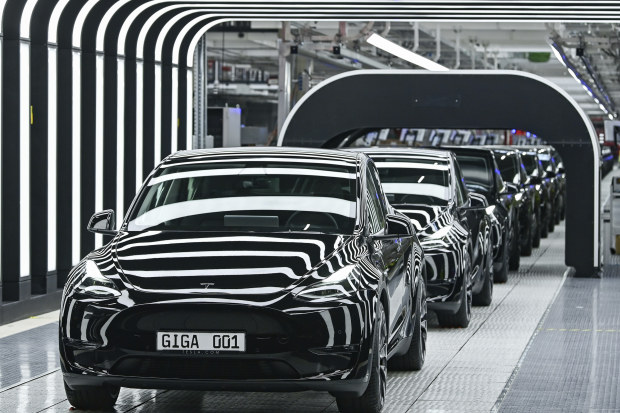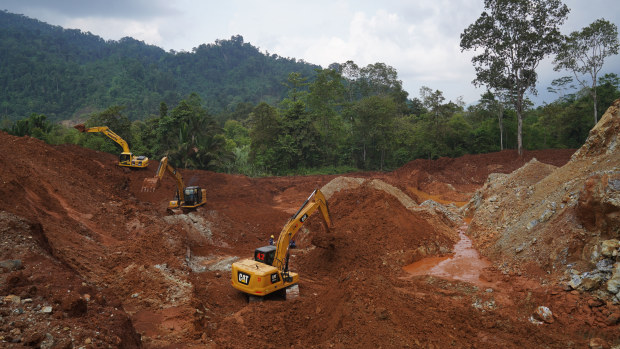Tesla investment a test for Indonesia’s nickel-powered EV dreams

Singapore | After losing out to Thailand in South-East Asia’s 1990s car manufacturing boom, Indonesia is determined to lead the region in electric vehicle production.
With a natural resources advantage, government incentives and a series of commitments from global car and battery makers, one of the world’s most successful economies amid the current gloom is now awaiting the seal of approval from Tesla founder and CEO Elon Musk.

Tesla Model Y electric vehicles on a conveyor belt at the opening of the Tesla factory in Berlin in March. AP
Mr Musk will be among the business leaders in Bali for the G20 Summit in November, when Indonesia will have another chance to sell its attributes as a one-stop EV supply chain, from its nickel reserves – the largest in the world – to battery and final production.
In July, Indonesian President Joko Widodo, commonly known as Jokowi, travelled to Tesla headquarters in Texas to meet with the billionaire.
The following month, the government announced Tesla had signed $US5 billion ($7.8 billion) worth of deals to buy nickel from companies operating at the Indonesia Morawali Industrial Park (IMIP) on Sulawesi Island, which has become central to the nation’s push to advance from production of nickel class two to class one – the kind used in EV supply chains.
However, Mr Musk’s on-again, off-again Twitter takeover took precedence over his Indonesian plans at the time, Jakarta said. The Jokowi government is hoping this will have changed by the November summit.
Earlier this year, Tesla executives visited nickel mines in Sulawesi, including one operated by the ASX-listed Nickel Industries as the company considers what’s on offer. Nickel Industries managing director Justin Werner believes Tesla is serious about its plans for Indonesia.
“The Indonesian government’s goal is to be the centre of production for cheap EVs for South-East Asia, and they are moving further and further along that value chain,” Mr Werner said.
“First it was nickel, now they’ve got battery makers, including CATL, breaking ground. Every major car manufacturer in the world is looking at Indonesia,” Mr Werner said.
The government has used export controls on iron ore to consolidate Indonesia’s position as a global leader in the supply of nickel to the stainless-steel industry.
It plans to do the same in electric vehicle production by processing limonite, the iron ore that can produce the sulphides for the EV battery market but was previously discarded because the leaching process was too costly, analysts say.
Indonesia lost out to South-East Asian nations such as Thailand in the fight to secure production of combustion engine vehicles. But it has a huge natural advantage when it comes to EVs, Citi analysts wrote in a recent research note.
Indonesia has lagged other countries by more than 50-100 years in combustion-engine manufacturing but “every country in the world is roughly on the same level playing field for the EV industry since this is a new development”, the analysts wrote.
“Indonesia has an additional benefit due to its significant nickel ore reserves which are the main material for EV battery production.”
Tesla has not yet announced any concrete investment plans. Citi noted Hyundai had already begun EV production in Indonesia, as had China’s GM Wuling. Citi tips Japanese car companies to do the same.
Ford Motor has signed an MOU with China’s Huayou Cobalt and miner Vale to build a high pressure acid leaching (HPAL) plant in Southeast Sulawesi to produce nickel-cobalt mixed hydroxide that can be further refined into a battery grade product.

Excavators in a pit at a nickel mine in Central Sulawesi. Bloomberg
While that facility is some years away from completion, Huayou has also developed an HPAL plant at IMIP that is expected to start production later this year.
These two HPAL plants, along with a third by a new venture, QMB, that’s majority-owned by China’s GEM, have helped put Indonesia on the map for carmakers as demand increases for battery raw materials.
Environmental concerns could yet derail Jakarta’s plans. In July, the Indonesian Forum for Environment wrote to Mr Musk, asking him not to go ahead with investments in Indonesia.
The group teamed up with US civil groups to detail what it said was extensive damage caused by the nickel industry. It warned tailings from nickel mines were destroying rainforest and polluting water supplies. Fishing hauls are down and because the mines are often on small islands, a blind eye is turned to illegal activity.
A recent report from the Brookings Institution concluded that Indonesia’s nickel sector was “particularly carbon intensive and environmentally damaging” and this created “an awkward challenge” for EV makers under pressure to manage environmental, social and governance issues in their supply chains.
Mr Werner said Western companies needed to educate themselves about modern Indonesia.
“Tailings are an unfortunate fact of life for every mining operation. There was this view in the West that ‘we will never go to Indonesia because it’s dirty nickel’. But now Ford is here, VW is here, Peugeot is looking around.
“Indonesia’s nickel has historically been in a form that’s been very costly and difficult to process. But that’s all changed,” Mr Werner said.
Subscribe to gift this article
Gift 5 articles to anyone you choose each month when you subscribe.
Subscribe nowAlready a subscriber?
Introducing your Newsfeed
Follow the topics, people and companies that matter to you.
Find out moreRead More
Latest In Asia
Fetching latest articles